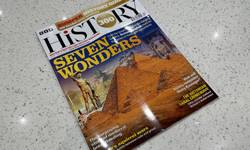On Christmas Eve 2013, we sat like the Bethlehem shepherds and watched as the traffic spiked and jammed our BBC Good Food website, peaking at over one million visitors. These were desperate people. “What do I do with this huge turkey that’s squatting on my kitchen worktop?”, “How do I make bread sauce?”, “Do you have a quick and easy recipe for mince pies?” Help!
It’s not surprising that desperate people turn for help to a trusted source – the UK’s biggest and most authoritative food media brand. But what is truly extraordinary is how we became that font of all food knowledge in the first place. I’d like to say it was all about thought-through publishing and strategic focus – but the truth is that like all great publishing, there was a generous helping of luck and a pinch of creative intuition, too.
Monopoly days numbered
This story begins more than a quarter of a century ago. BBC Magazines was a one-trick pony, albeit of dray-horse proportions in the form of Radio Times, the biggest and most lucrative magazine title in Britain at the time. But it was a lazy and monopolistic magazine, too, devoid of colour and with ads for garden sheds, stair lifts and incontinence pads interrupting the flow of TV and radio listings. And there were dark clouds ahead: incredibly, the magazine had enjoyed since its birth in 1922, the exclusive legal copyright for the BBC’s seven-day schedule of programmes, but it was clear in the competition fever of the Thatcher years that we would shortly lose this monopoly and there would be an open market for television listings heralding in new magazine entrants and a slew of TV supplements in newspapers.
I was recruited from The Times, where I’d been features editor, as the eleventh editor of Radio Times to prepare RT editorially for the battle ahead. I was also made editorial director of BBC Magazines – a rather grand title considering our only other title was a 50% stake in BBC Wildlife magazine – and together with Peter Phippen, the also new publishing director of BBC Magazines, we were asked to come up with a Plan B in case we lost the TV listings war and the BBC’s revenues from Radio Times began to dry up.
Highlighter pen
So, for want of knowing where else to start, a few of us gathered in a conference room with a copy of Radio Times and a highlighter pen. The conversation went like this. “Top Gear… BBC2… 2.2 million viewers. The nation’s favourite motoring programme. It calls itself a ‘magazine’ programme… I wonder if it would make a magazine?” Whoosh went the highlighter pen and six months later we launched BBC Top Gear magazine. “Gardeners’ World”… “Top of the Pops”. And so on and so on… it was a simple but inspired formula. We took BBC intellectual property and considered if it could be turned into a magazine.
And so began an incredible publishing adventure that saw us launch our way to become the UK’s third largest magazine company with more than fifty titles. The humble highlighter pen. There was no more science to it than that.
One day around that time, we got a call from Peter Bazalgette – now Sir Peter Bazalgette, chair of Arts Council England. At the time, he was the producer of the BBC’s enormously popular Food and Drink programme. “I hear you’re launching magazines like topsy,” he said. “How about a food magazine?”
We were sceptical. What few food magazines there had been – most of them at the posh end of the market - had closed and there wasn’t really a food category at newsstand. But the editorial proposition couldn’t have been simpler (or better) – “you’ll find every recipe you’ve seen on TV in this magazine”.
BBC Good Food magazine launched in October 1989 and it was a smash hit from the off.
Brand extensions
So, drunk on our success and high as kites on entrepreneurialism, we wondered what to do next? It’s hard to imagine now in these days where 360-degree, multi-platform brand building is de rigueur that back in the 1980s, simply talking brand extensions was considered radical talk. Our visionary leader and the architect of BBCMagazines, Dr John Thomas, was ahead of that curve. John postulated that the success of BBC Good Food and BBC Gardeners’ World magazines had largely been built on an evangelical obsession for getting close to our readers. So, he said, “Why don’t we go the whole hog and meet our readers face to face?”
We launched BBC Good Food Live at the National Exhibition Centre, Birmingham, in November 1990, literally bringing to life the magazine’s editorial concept – getting our food team and celebrity chefs to create dishes and demonstrate how to make them. Today, we have live shows throughout the year in London, Birmingham, Glasgow, Harrogate and Hampton Court with more than 250,000 “readers” experiencing the brand for real.
Next it was books. Well, when you’re creating and testing new recipes every day, it’s only natural to think what else you can do to sweat the burgeoning database of recipes. The Good Food series has sold over 3.5 million copies to date making it the BBC’s bestselling non-TV tie in brand. BBC Good Food Bakes & Cakes is the bestselling book of the series; it’s sold over 335,000 copies.
The C-word
Our website, bbcgoodfood.com, was slow out of the blocks, principally because we endlessly and tiresomely debated the C-word – cannibalisation. “Wouldn’t a recipe-based website simply steal food off the plate of our print magazine?” And then finally the penny dropped – if our fans were plumping for digital over print then wouldn’t we rather they switch from one Good Food product to another than go elsewhere? From a late start in October 2006, the website built up huge traction to become what it is today, Britain’s most popular food destination.
And this is a good point to take overall stock of the Good Food brand today. At its content creation heart is the Good Food Kitchen where over the 25 years, an expert cookery team has created around 15,000 original recipes – and growing. Every month, the team dreams up another 50 brand new recipes, all of them triple-tested to ensure “they work first time for you”. The kitchen’s two dishwashers run 60 times a month - that’s about 200 mixing bowls, 100 pans and a lot of cutlery! – and we get through 100 eggs, 3kg each of sugar, flour and butter, and generate about 25 bin-bags of glass, plastic and other recyclable waste every month. Our food bill is around £2,000 a month and we send everything we can to the local food bank.
In addition, our editorial teams take around 150 calls and emails a month from Good Foodies who want our advice on recipes, ingredients, kitchen equipment, catering for parties, making wedding cakes… and much more.
This is a brand that boils over with accolades and statistics. Number one for food in print and digital media, BBC Good Food is the “magazine” brand with the largest reach of any magazine brand, according to NRS’s new PADD research, including print, mobile, tablet and desk-top internet. We are now fully responsive as working on mobile is key to our success. We now have the biggest monthly reach of 6.1 million (that’s 10 million-plus before the duplication is combed out), with that figure climbing by more than a million in two months alone last autumn. It easily beats the reach of other UK household brands such as Radio Times, Cosmopolitan, Heat and Hello!.
Herding cats
Although we’d long recognised that this was a multi-platform brand rather than a magazine with a collection of brand extensions, it was only as recently as eighteen months ago that we made a concerted effort to manage it as such. And that’s been no mean feat. Through an accretion of publishing layers over the years and perhaps a degree of BBC risk aversion and policy constraint, we’d created a publishing camel: the website is wholly owned and operated by BBC Worldwide out of the Media Centre in White City; the magazine by contrast has been contract-published for us by Immediate Media since November 2011 – and from a separate location; live events are licensed to River Street Events in yet another part of London; books are published under the Ebury imprint by colleagues in our joint venture with Penguin Random House in Vauxhall; and our network of international magazine editions – currently six titles - have been grown through licensing.
Herding cats would seem straightforward in comparison. But combined with a galvanising wave of goodwill and love among all our partners for the brand and everything it stands for, the task has been surprisingly easy since we set up a small brand team – a publisher, a creative director, a marketer, and a soon to be appointed food director – to provide commercial, brand and editorial direction. It might have taken us 25 years but we now have our first overarching brand strategy and such basic publishing essentials as a consolidated brand P&L. And as a birthday treat to ourselves, we commissioned Lambie-Nairn, the legendary design company, to give us a complete make-over in readiness for the next quarter of a century.
And what does that future hold for us? In the short term, we are consolidating and building on all the good brand work of the past eighteen months to ensure we have a tighter and even more homogeneous brand offering and we are extending our editorial reach from our pre-eminent position as the expert in cooking to encompass all things food. We want to lead the national conversation on food. There’s plenty more under strategic wraps but as an appetiser let me offer you this – could our Good Food Kitchen be more consumer-facing? How cool would it be to sit and watch the recipes being created and then get the chance to sample our wares?
And, yes, we do have a recipe for “quick mince pies”. You can find it here.












